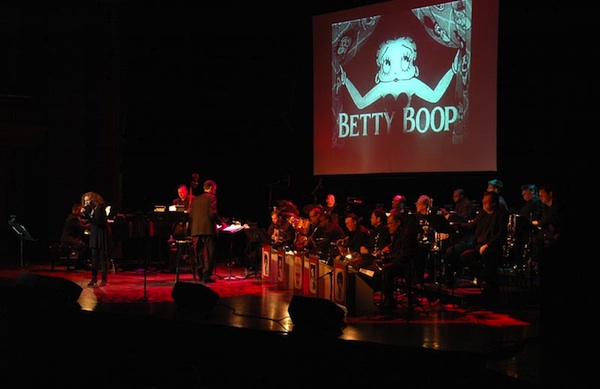
Betty, Cab, and Louis
By Gregory Lucas-Myers, Charles H. Wright Museum of African American History On October 15 and 16, 2011, the Wright played host to “Rhapsody in Boop,” a musical tribute to the big band jazz that helped to turn a cartoon character into an icon. The songs of greats that leant their music to Betty Boop’s cartoons, such as Cab Calloway and Louis Armstrong, were performed by Kathy Kosins, The Paul Keller Orchestra, and a selection of Detroit-based and national artists including Dwight Adams, Sean Dobbins, and more. Museum intern Gregory Lucas-Myers gives his impressions on the subjects of the evening.
The decision to attend “Rhapsody in Boop” was a no-brainer. I enjoy jazz. I enjoy animation and animation history. I was not disappointed in the least, as lively string bassist Paul Keller laid the foundation of the music for the rest of his band to kick off, song after song performed to perfection. Detroit drummer Sean Dobbins brought his signature fire to the toms and hi-hat, while Kathy Kosins took over songs with her ability, including those originally performed by men. Trombone and saxophone solos interjected themselves into songs freely. Amidst the vintage songs, photos of the Jazz Age musicians, and stills of Ms. Boop’s cartons, I enjoyably listened along without any expectation of being surprised or provoked. That changed when the band got to one song and accompanying cartoon in particular.
The 1933 cartoon “Any Rags?” features Betty’s canine beau Bimbo in the role of a junk collector that goes about collecting scraps, trash, bones, people’s clothes while they’re wearing them, a barber shop pole stripe, and other things in the way only a cartoon can, all the while singing and dancing along to a catchy jazz beat. Preceded by the residents singing the 1931 song “Call of the Freaks” (“Stick out your can, here comes the garbage man!”), Bimbo arrives at the apartment building where Betty is staying. Becoming immediately smitten with each other, Betty tosses a large bag of trash to him and he continues on his way. While auctioning off the junk he collected, Bimbo is surprised to find that Betty’s garbage bag contains a special item – Betty herself! The two smooch and dance as Bimbo’s junk cart careens down the road before flipping over, forming a house out of all the trash, and the two live happily ever after.
But, let’s rewind it back to when Bimbo arrives at Betty’s apartment building. “Stick out your can, here comes the garbage man!” might be an innocent exclamation on its own. Now, throw it in as a lyric to an incredible jazzy dance song. Then, have the central focus of the chorus of singers be the unmistakably hip, eternally youthful, near-fearless sex icon that is Betty Boop.
And, finally, while Betty is exchanging pleasantries with Bimbo from her apartment window, have the top of her dress repeatedly fall down for no reason whatsoever, flashing her bra.
This mixture of elements all comes together to give an exaggerated sketch of what was a very real movement of the time. Betty Boop herself is an obvious example: her short skirts, short curly hairstyle, womanly body, and cartoonish baby face evokes images of flapper girls and night clubs, while retaining a sort of innocent charm. Though they are not present in “Any Rags?,” Betty Boop’s parents do make a feature in my favorite Betty Boop short, “Minnie the Moocher,” and they are obvious send-ups of European immigrants, creating a generation conflict with their Americanized daughter. The overly urban settings of Betty’s cartoons, such as in “Any Rags?,” is an example of an increasing population shift from the rural farmlands to the manufacturing and professional prospects of the city, and the urban sensibilities that came along with them.
Most important in gluing this all together, however, is the music. Just from the cartoons already mentioned, one can see (or, rather, hear) the influences. “Call of the Freaks” in “Any Rag?” was originally created by Luis Russell and his band, which included Louis Armstrong, who would eventually go on to inherit leadership of the band; Armstrong also did music for the Betty cartoon “I’ll Be Glad When You’re Dead You Rascal You.” Cab Calloway leant both his music and his dance moves (via rotoscoping, an animation technique of tracing over film of a live actor to create the cartoon image) to “Minnie the Moocher,” “Snow White,” and “The Old Man of the Mountain.” With the prominence of the Betty Boop cartoons and the simultaneous growing popularity of jazz itself, the influence of African-American culture can be seen to really morph and direct popular culture itself.
Not a bad résumé for a girl that started off as a poodle.
The Charles H. Wright Museum of African American History is the world’s largest institution dedicated to the African American experience. For more information on this and other events, past, present, or future, please visit www.TheWright.org.
Recent Content
-
Artsarticle ·
-
Artsarticle ·
-
Artsarticle ·

